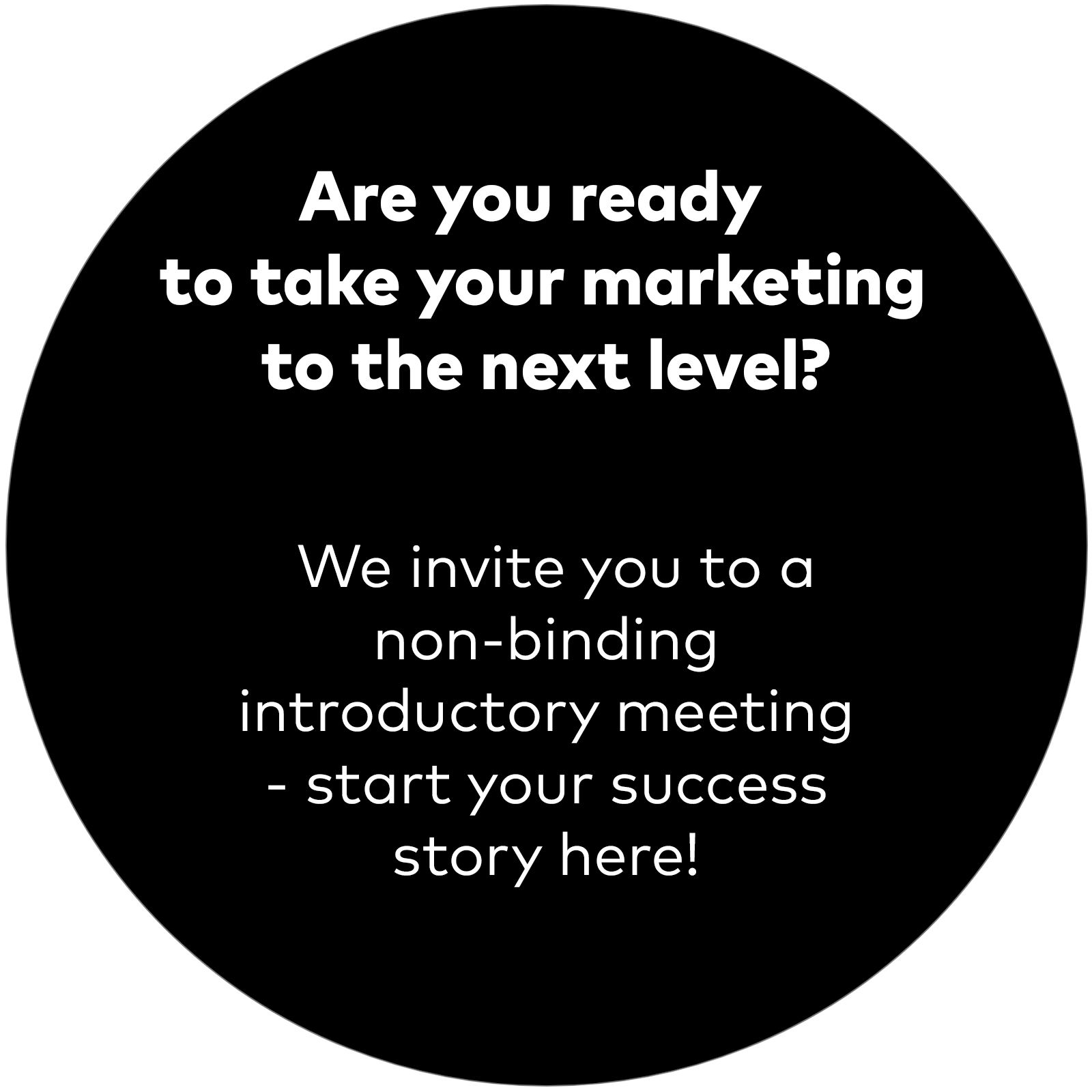
Latest frameworks beyond the funnel & AIDA model
Unleash the full potential of your marketing strategy: In this guide, we dive into the world of marketing frameworks and show you how to use them with the latest tools and targeted AI prompts. Based on the experience of hundreds of consulting projects, you will receive practical tips for direct application. Get ready to outperform your competition with these frameworks and tools!
Download the latest presentation (Marketing Masterclass: 15 Marketing Tools + Sales & AI Prompting Frameworks in 30 minutes) & helpful templates from the Digital Bash Marketing Tool Day here.
Are you ready to take your marketing to the next level? The more than 600 experts at GROW Digital Group will be happy to help you further expand your e-commerce & marketing success. We invite you to a non-binding introductory meeting – start your success story here
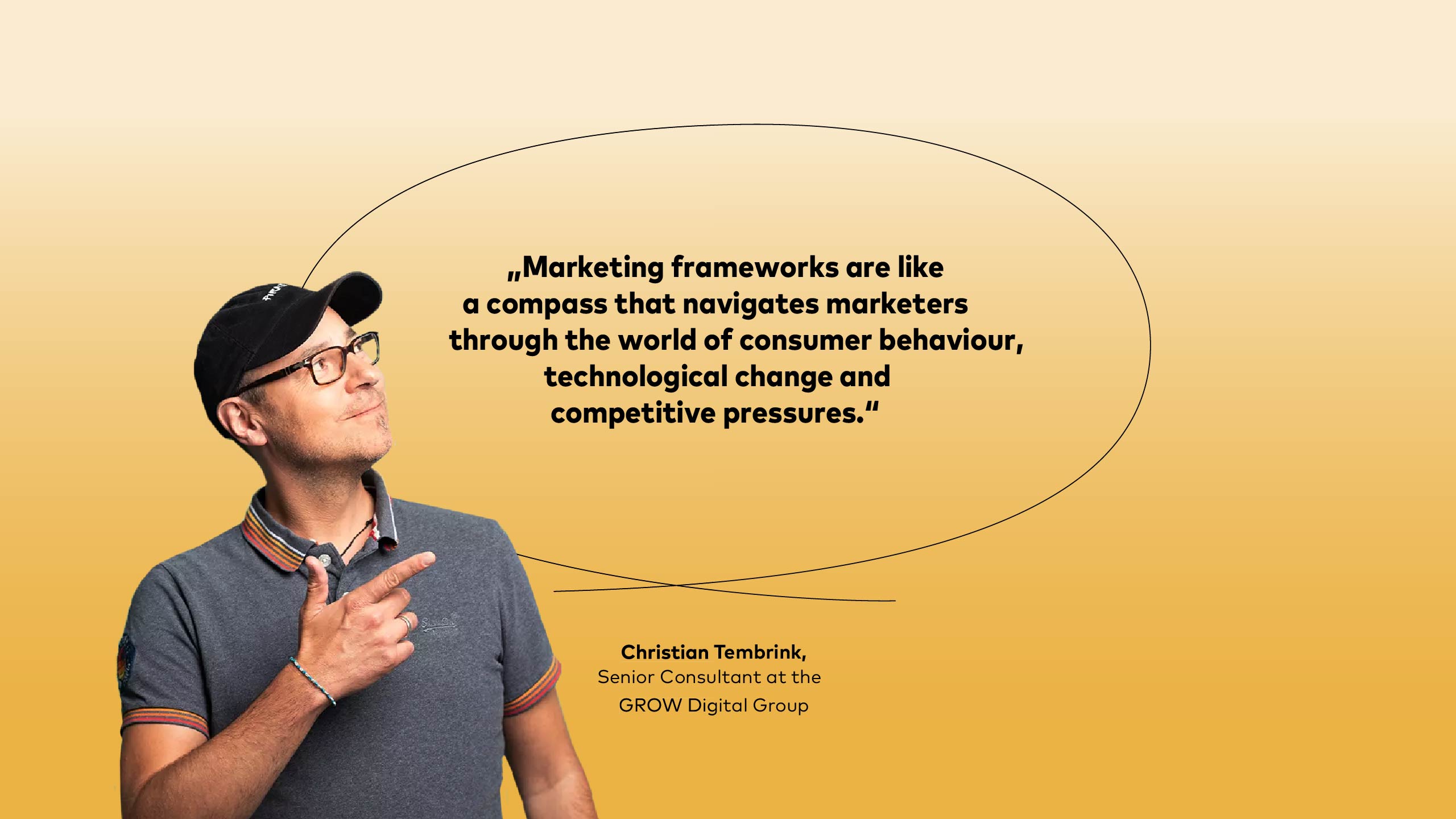
Getting started with marketing frameworks
Marketing frameworks are like a treasure map for your strategy. They help you to structure and simplify complex marketing strategies and shed light on your market and target group. They help you to find out where you stand and how you can focus your marketing even more sharply and effectively. The experts from the GROW team are convinced that with frameworks you are relying on proven methods that really work!
4 facts about marketing frameworks
-
Marketing frameworks date back to 1898, when the foundation stone was laid for the AIDA model – a marketing framework that is still widely used today and that you have probably used before, right?
-
Frameworks that have become outdated, such as the 4-P model, have been continuously expanded (now the 7-P model) – this helps you to revise your own strategy in line with the times
-
Completely new frameworks combine old rules with new AI possibilities and data analyses.
-
Many new frameworks specifically take into account the changes in user behaviour brought about by the internet and mobile devices – and this is exactly what we focus on!
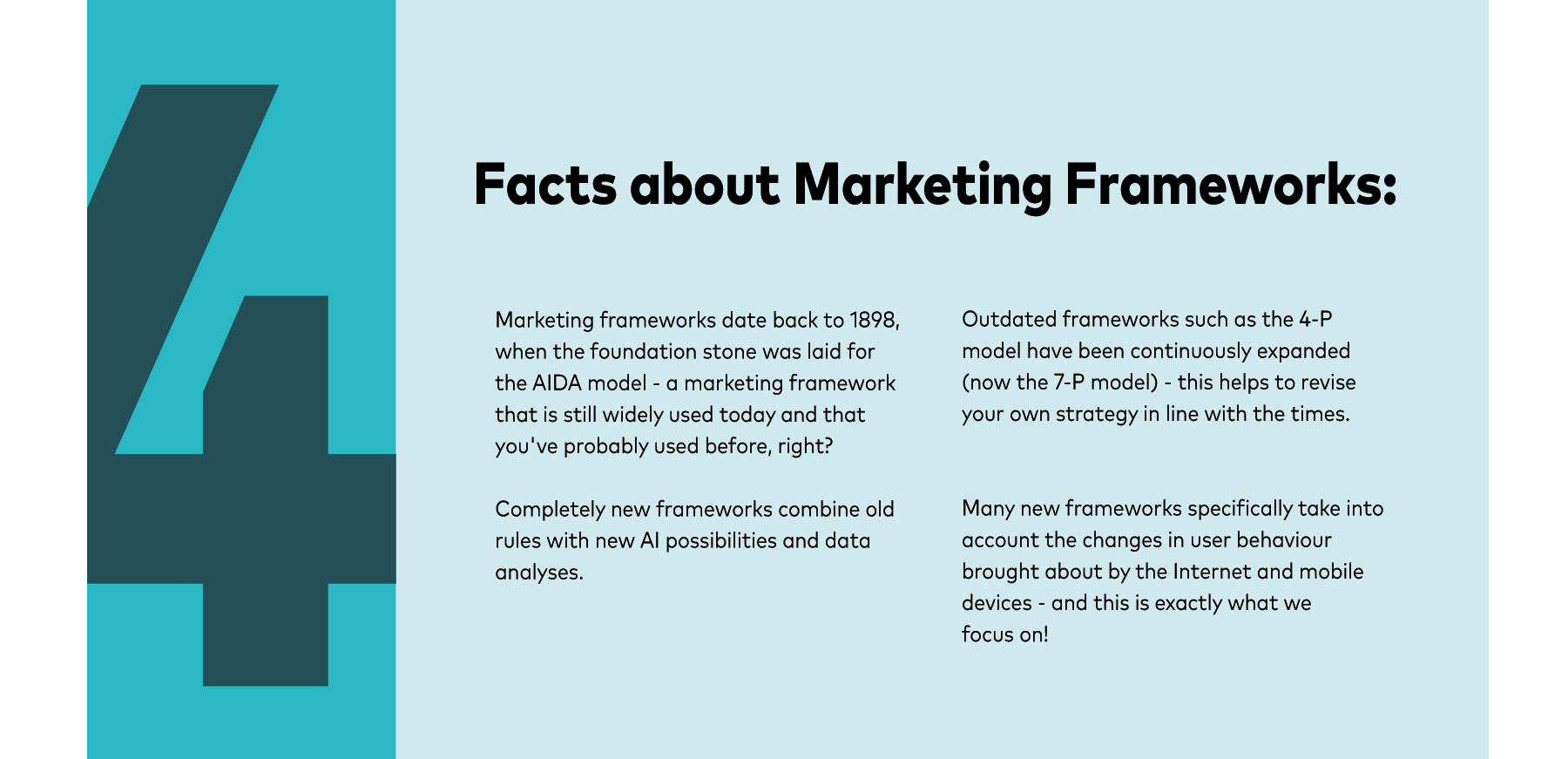
What are marketing frameworks
A marketing framework is like a navigation device that shows you the way through the world of marketing. It provides you with the central theme of how you can get your brand’s messages across effectively. It brings order to creative chaos and helps to provide each team member with a clear schedule. Frameworks synchronise the wheels in the marketing gears and bring ever-increasing efficiency and effectiveness to your advertising and marketing measures.

Further development: from the old AIDA framework to the latest AI framework
The history of marketing frameworks goes back to 1898 – where Elmo Lewis first described the AIDA model in his business. In a later report on advertising, he described three of the principles that form the basis of the AIDA model, which explains how advertising can have the right effect.
In 1960, E. Jerome McCarthy created a marketing framework that is also known worldwide: he proposed to divide the possibilities of marketing into 4 classic instruments – the so-called ‘Four P’s’ consisting of price, product, place and promotion.
Since then, thousands of new frameworks have been developed and researched. In particular, the changes in people’s purchasing decision behaviour brought about by the Internet are increasingly becoming the focus of attention. In addition to marketing faculties at universities, many management consultancies have also developed their own marketing frameworks, such as the BCG matrix developed by the Boston Consulting Group, which can also be applied to brands.
In the following, we will introduce you to newer frameworks and reveal the practical tools you can use for your marketing. You will also receive suitable prompts for each framework to help you apply the method correctly.
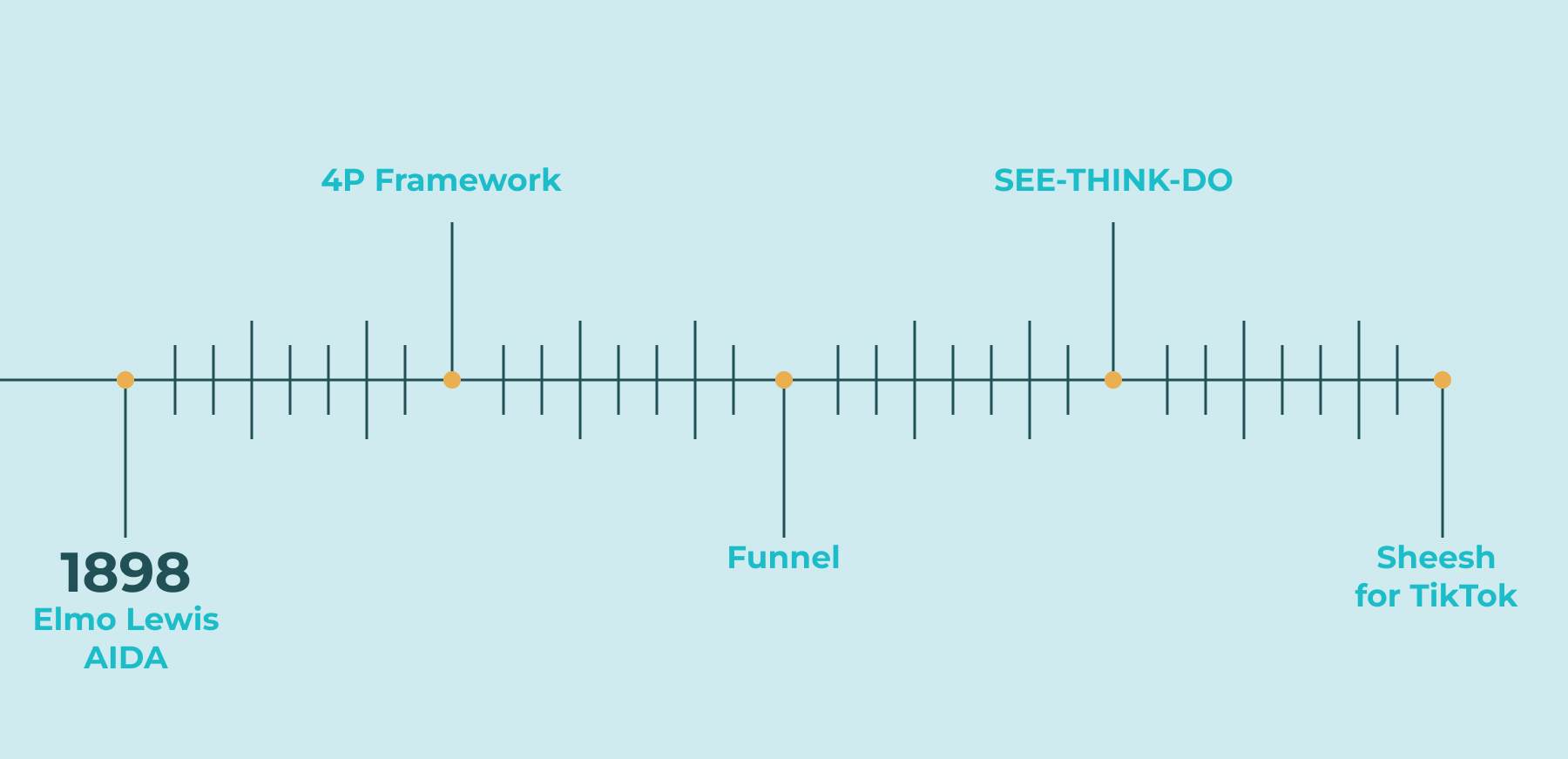
Latest strategy & digital marketing frameworks
Every day, we as potential customers are approached in the wrong channel with inappropriate formats. This is because many companies are still neglecting the fact that the internet and new technology are also changing our purchasing decision processes. That’s why we won’t go into detail here about the old strategy frameworks such as AIDA, the 4P model or the super widespread funnel model. Instead, you will learn about exciting new alternatives that will help you at a strategic and operational marketing level.

The STEPPS framework – ideal for social media and co.
Jonah Berger’s STEPPS model is a cool tool for understanding why some ideas spread like wildfire. It’s about how to create content so that people can’t help but share it. Here are the crisp points of the model:
Social currency: Make people feel cool when they share your content or tell others about your product. Think carefully about which motives you can appeal to your desired customers in order to entice them to spread and interact with your digital content.
Triggers: Create content that constantly reminds people of your brand – what influences and environmental factors can do this for you? Want an example? What do people do ‘at half past nine in the morning in Germany?’ – Would you like a Knoppers by chance?
Emotion: Arouse strong feelings so that sharing your message becomes a matter of the heart – so the aim here is to ignite an emotional fire
Public: Make your content visible so that it is recognised in everyday life!
Practical Value: Provide useful information that is worth passing on – does your message have practical added value in everyday conversations?
Stories: Wrap your message in stories that people want to tell – because storytelling is a powerful tool!
You can use these 6 steps to check whether there is potential for improvement in all your marketing messages.
Application areas of the STEPPS framework
Ideal for social media campaigns, content marketing and anywhere you want your message to spread like wildfire.
Pros
-
Great for creating viral campaigns.
-
Strengthens the bond with your brand.
Cons:
-
Not every campaign automatically becomes a viral hit.
-
It requires creative and unique ideas.
Prompts to help you apply the method:
In the prompts, add words such as target group, offer or product with precise descriptions for your market, industry and target customers. Or add the following note to the respective prompt suggestions: ‘If you are missing information for a good answer, please ask me questions.’
Phase in the Sheesh model
Social Currency
Prompt
1. “What exclusive or insider information can we offer our customers that they would like to share in their networks?“
Explanation of why the prompt helps
This prompt helps to identify content that gives users a sense of belonging and status when they share it.
Prompt
2. “How can we create a sense of belonging or “VIP status” for our users by showcasing our products or services?“
Explanation of why the prompt helps
This encourages the development of marketing strategies that address users’ need for social recognition.
Triggers
Prompt
1. “What everyday situations or objects can we associate with our brand to create a natural memory?“
Explanation of why the prompt helps
This prompt helps to identify content that gives users a sense of belonging and status when they share it.
Prompt
2. “How can we use seasonal events or holidays to create regular reminders of our brand?“
Explanation of why the prompt helps
This helps to identify timely points of contact for the brand in order to increase visibility and relevance.
Emotion
Prompt
1. “What emotional stories can we share that inspire or move our target group?“
Explanation of why the prompt helps
Sharing emotional stories builds a deeper connection with the target group and increases the likelihood that content will be shared.
Prompt
2. “How can we present our products/services in such a way that they evoke strong positive or surprising emotions?“
Explanation of why the prompt helps
This approach utilises the power of emotions to encourage engagement and sharing.
Public
Prompt
1. “In what ways can we encourage our customers to show or use our brand in public?“
Explanation of why the prompt helps
Encouraging customers to display the brand publicly increases visibility and encourages social emulation.
Prompt
2. “How can we incorporate striking, visually appealing elements into our products that stand out in public spaces?”
Explanation of why the prompt helps
This promotes the public visibility and recognizability of the brand, which helps to spread the word.
Practical Value
Prompt
1. “What tips or advice can we offer that will make our customers’ daily lives easier, better or more cost-efficient?”
Explanation of why the prompt helps
This prompt helps create content with high practical value that users are likely to share to help others.
Prompt
2. “How can we prepare complex information or data in a simple, easy-to-understand and applicable way for our target group?”
Explanation of why the prompt helps
This makes it easier for the target group to recognize and use the value of the information, which encourages sharing.
Stories
Prompt
1. “What compelling stories can we tell about our brand or products that will spread like word of mouth?”
Explanation of why the prompt helps
Stories build an emotional connection and remain in the memory, which motivates people to pass them on.
Prompt
2. “How can we use the experiences or success stories of our customers to create authentic and relatable stories?”
Explanation of why the prompt helps
Sharing user experiences creates credibility and resonance, which promotes the distribution of content.
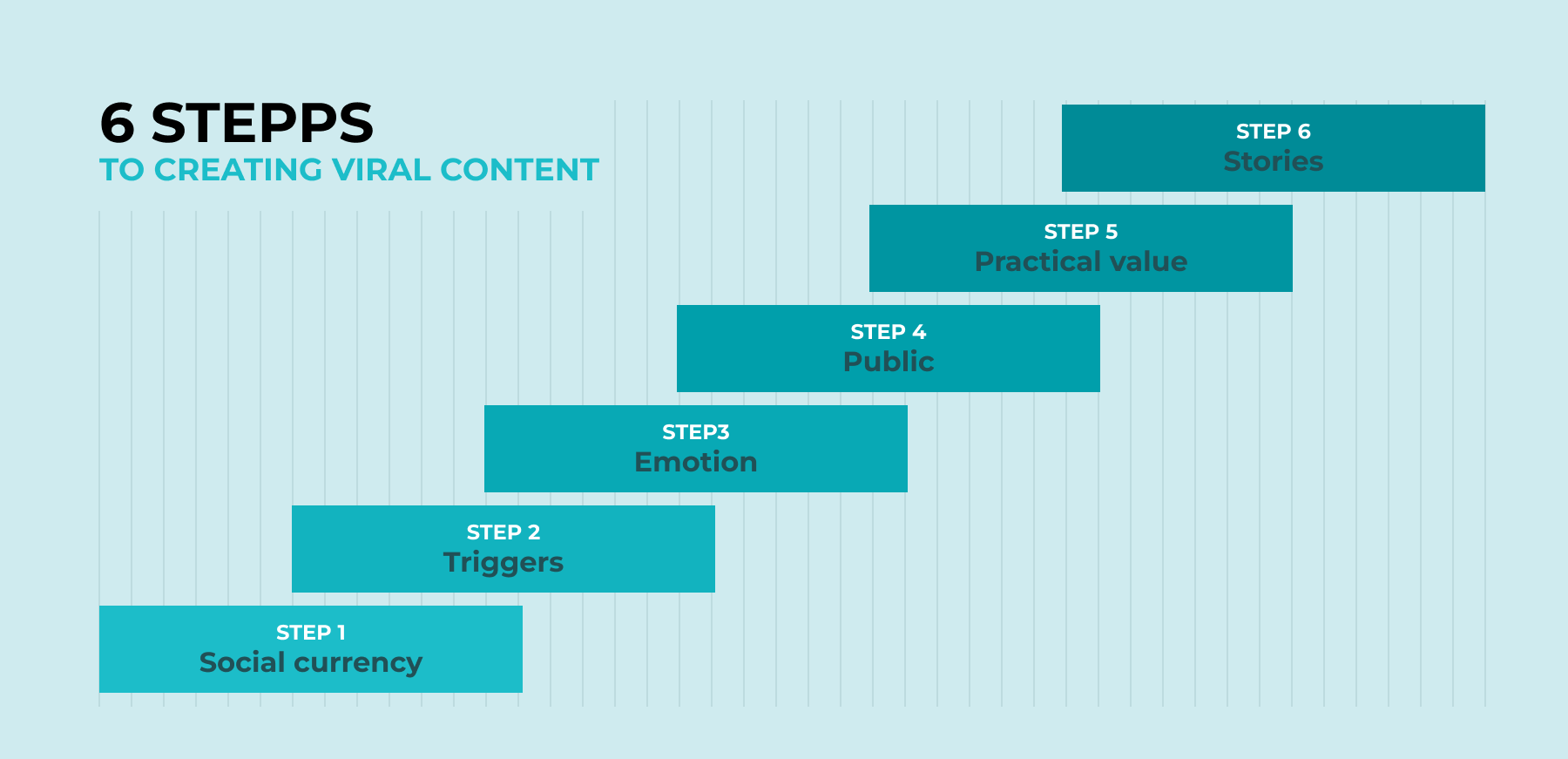
The SHEESH Framework – Ideal for Insta, TikTok & YouTube Shorts
You probably know that once you start with Instagram, TikTok or YouTube shorts, there’s no stopping you. Just one more clip… But now the last one. Oh, one more video…and another hour has passed…
Placing (advertising) messages at this high consumption frequency needs to be learnt. This is exactly where the Sheesh formula comes into play – it forces you to always keep the following points in mind when planning shorts, TikToks or story content. This framework is particularly suitable for organic video content.
-
Scrollstopper: Use an unusual preview image or video entry to ensure that users can’t help but want to continue watching your content. Clarity, simplicity, a combination of visual stimuli and strong statements using typography can be the key to success here. All that matters is an idea that leads to a scroll stop in the context of all the other content because it stands out.
-
Humour: Once the first step has been taken, a pinch of humour helps enormously! Whether absurd, ironic or just plain weird: anything that makes the viewer smile is allowed. So dare to cross boundaries and think less about the factual logic of your advertising and more about the joy of the viewer. Because happy users will actually look at your content!
-
Uniqueness: Goes hand in hand with the first point – because it’s about breaking out of the standards and offering something unusual. And coming up with just such an idea is not that easy – fortunately, Chat GPT also helps you to develop unusual script approaches for TikTok and co.
-
Entertainment: What distinguishes users of social media platforms from those who use a search engine? That’s right, people who use social media are generally looking for entertainment. It is therefore essential to include the right amount of entertainment – this is where storytelling scripts help you to create a suitable (short) story that is sufficiently entertaining.
-
Surprise: You’re almost there – and if there’s a sudden twist or surprise in your TikToks, you’ve done everything right and you’re sure to get lots of views + feedback!
-
Handwriting: The last point is to develop a personal signature. In other words, something that ensures that your clips have a recognisable value that cannot be found anywhere else.
You can use these 6 steps to check whether there is potential for improvement in all your marketing messages.

Application areas of the SHEESH Framework
The Sheesh formula proves to be an innovative framework specifically designed to stand out in the endless flood of content on platforms like TikTok and YouTube Shorts. This method is particularly beneficial for businesses and content creators looking to create organic video content with the aim of standing out in the crowd and building a loyal audience.
Pros:
-
Increased attention: Creative and unique content that makes users pause is more likely to make your content stand out from the crowd.
-
Increased engagement: Humor and entertainment encourage interaction with the audience, leading to higher engagement and stronger retention.
-
Branding: Developing a personal signature supports the building a recognizable brand that attracts viewers in the long term.
Cons:
-
Creative pressure: The constant need to be unique and surprising can put significant creative pressure on content creators.
-
Time-consuming: Carefully planning and implementing each of these elements can be time-consuming, especially for individuals or small teams.
-
Lack of universality: What works for one audience may not necessarily resonate with another, which can limit the effectiveness of the Sheesh formula, depending on who the target audience is.
Prompts to help you apply the method:
Be sure to add precise details about your target groups, the things that characterize your brand and tonality to the initial prompt suggestions below. If you lack knowledge here, add the following note at the end of your prompt: First ask me a few questions to develop a prompt that promises maximum success.
Phase in the STEPPS model
Scrollstopper
Prompt
1. “What visual element can we put at the beginning of our video that immediately catches the eye and arouses curiosity?”
Explanation of why the prompt helps
This prompt helps to optimize the crucial first impression to break the user’s scrolling habit.
Prompt
2. “How can we design the first few seconds of our content so that it immediately triggers a question or amazement in the viewer?”
Explanation of why the prompt helps
This encourages content to be designed in such a way that a cognitive anchor is immediately set, motivating the viewer to continue watching.
Humour
Prompt
1. “How can we break familiar patterns or turn clichés on their head to make our content unique?”
Explanation of why the prompt helps
Humour builds a positive connection with the viewer and increases the chance that the content will be shared.
Prompt
2. “What everyday situations can we present in an unexpected or exaggerated context to create humour?”
Explanation of why the prompt helps
This approach utilises the power of relatability and exaggeration to create humorous moments that will be remembered.
Uniqueness
Prompt
1. “How can we break familiar patterns or turn clichés on their head to make our content unique?”
Explanation of why the prompt helps
By deliberately breaking with expectations, you create unique moments that stand out from the crowd.
Prompt
2. “In which area can we be radically different from everything that has been seen on the platform so far?”
Explanation of why the prompt helps
This prompt encourages creative thinking and innovation to achieve true uniqueness in content.
Entertainment
Prompt
1. “How can we package our product or message in a short, compelling story that entertains the audience?”
Explanation of why the prompt helps
Stories capture and retain attention, which is essential for successful engagement on social media.
Prompt
2. “What elements of drama, tension or joy can we incorporate into our video to evoke an emotional response?”
Explanation of why the prompt helps
Emotionally charged content promotes the bond with the viewer and increases the willingness to share.
Surprise
Prompt
1. “How can we integrate an unexpected twist or an unpredictable element into our content that will amaze viewers?”
Explanation of why the prompt helps
Surprises capture attention and make the content memorable, which leads to more engagement.
Prompt
2. “Can we surprise the viewer with a sudden change in tone, style or perspective?”
Explanation of why the prompt helps
This creates a moment of wonder or amazement that arouses curiosity and encourages people to stay.
Handwriting
Prompt
1. “What recurring visual or thematic element can we establish in our videos that will become our trademark?”
Explanation of why the prompt helps
A consistent signature ensures recognition value and strengthens brand loyalty.
Prompt
2. “How can we clearly express the personality of our brand or that of our protagonists in every video?”
Explanation of why the prompt helps
This prompt helps to build an authentic and unmistakable brand personality that users recognise and appreciate.
Forrester’s 5 i model – the alternative to the marketing funnel
The Forrester 5 i model puts the customer at the center of all marketing considerations and helps you to build a close relationship with your customers by focusing on five key phases:
- Involvement (catching the customer’s eye so that the brand is consciously perceived),
- Interaction (interaction and points of contact: Which interaction can be encouraged in which channel?),
- Intimacy (the emotional closeness between customer and brand: how do we build this up?)
- Influence (the factors influencing the purchase decision – such as buying motives) and
- Individualization (the personalization of the customer approach).
These phases offer the opportunity to refine your marketing strategies and develop a deep relationship with your customers. Think of the Forrester 5 i model as a relationship guide between you and your customers. It shows you how to build a strong bond with your customers through five key stages – Involvement, Interaction, Intimacy, Influence and Individualization. Away from the old marketing funnel and into a world where you accompany your customers throughout their journey.
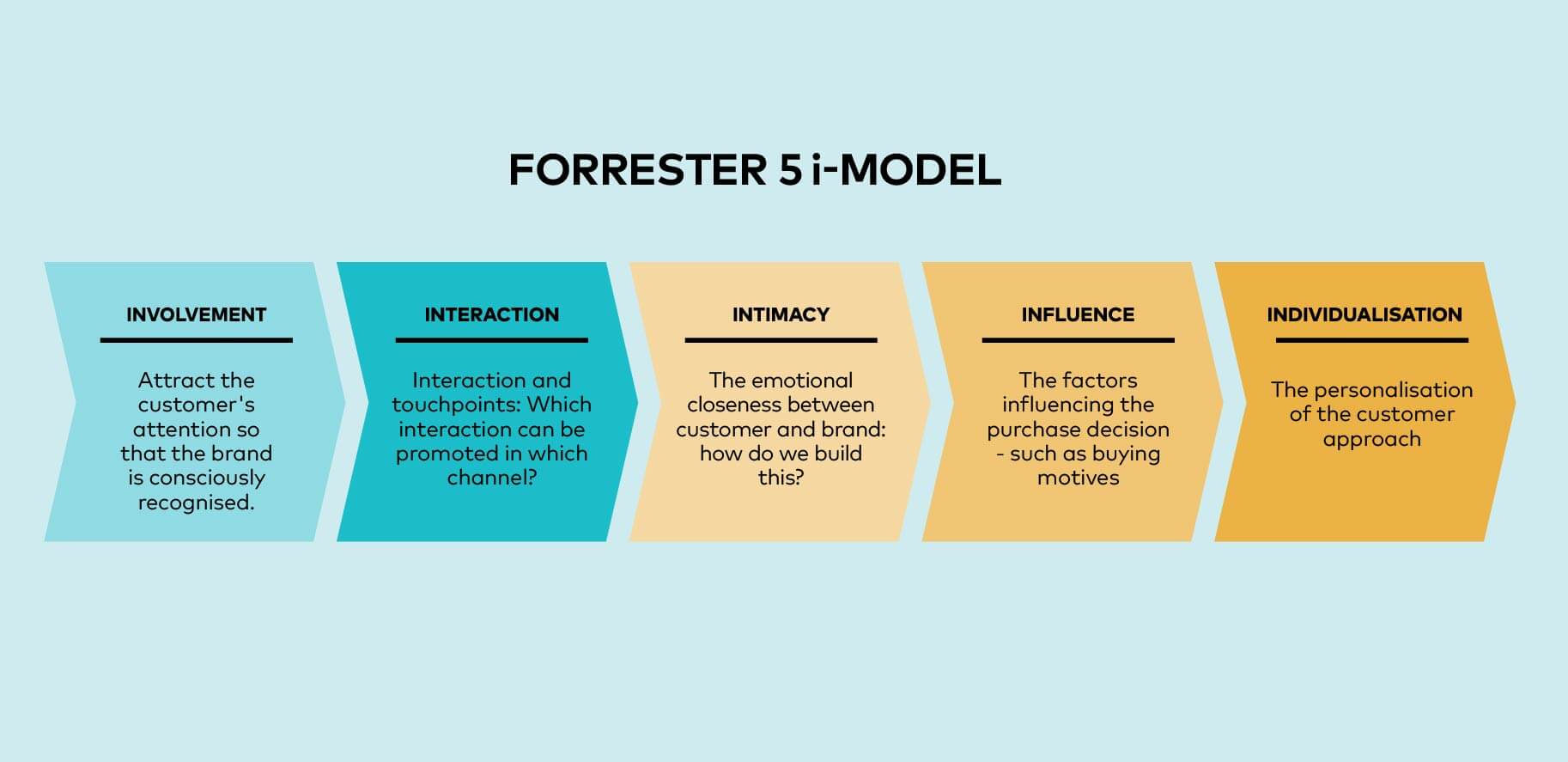
Scope of the Forrester 5i Framework
- Perfect for digital campaigns that focus on long-term relationships.
- Ideal for brands that really want to understand their customers and address them individually.
Pros:
-
strengthens customer loyalty through a personalised approach.
-
Provides a comprehensive understanding of the customer journey.
-
Promotes innovative marketing strategies that go beyond the purchase.
Cons:
-
Can be time and resource intensive as it requires in-depth customer analysis.
-
Requires constant adaptation and updating to keep pace with customer growth.
Prompts to help you apply the method:
Be sure to add precise details about your target groups, the things that characterize your brand and tonality to the initial prompt suggestions below. If you lack knowledge here, add the following note at the end of your prompt: First ask me a few questions to develop a prompt that promises maximum success.
Phase in the Forrester 5 i-model
Involvement
Prompt
1. “How can we immediately attract the attention of our target group through visual design or content?”
Explanation of why the prompt helps
This prompt focuses on creating eye-catching elements that ensure the brand is recognised by customers.
Prompt
2. “Which values or trends are particularly important to our target group and how can we integrate them into our brand message?”
Explanation of why the prompt helps
This encourages the identification of relevant and appealing topics that attract the attention of the target group.
Interaction
Prompt
1. “Which channels are our customers most active on and how can we initiate meaningful interactions there?”
Explanation of why the prompt helps
The prompt helps to recognise where and how the company can interact effectively with customers to encourage engagement.
Prompt
2. “What kind of interactions (e.g. surveys, live chats, competitions) can we use to deepen the dialogue with our customers?”
Explanation of why the prompt helps
This encourages thinking about creative and effective ways to establish two-way communication with the target group.
Intimacy
Prompt
1. “How can we use stories to create an emotional connection between our brand and customers?”
Explanation of why the prompt helps
Stories are a powerful tool for arousing emotions and deepening brand loyalty.
Prompt
2. “How can we reflect the needs and wishes of our customers in our communication to show empathy and understanding?”
Explanation of why the prompt helps
This approach promotes empathy and understanding, which is essential for building intimacy.
Influence
Prompt
1. “Which factors influence the purchasing decisions of our target group the most and how can we address these in our marketing strategy?”
Explanation of why the prompt helps
The prompt aims to understand the main motivators of the target group and to address them specifically in order to increase the incentive to buy.
Prompt
2. “How can we use testimonials, case studies or customer reviews to strengthen the trust and credibility of our brand?”
Explanation of why the prompt helps
This helps to utilise social evidence as influencing factors that can positively influence the purchase decision.
Individualisation
Prompt
1. “How can we use data and customer feedback to create personalised experiences and offers?”
Explanation of why the prompt helps
Personalisation shows customers that their individual needs and preferences are recognised and valued, which strengthens customer loyalty.
Prompt
2. “In which areas can we adapt our service or our products to offer unique customer experiences?”
Explanation of why the prompt helps
This promotes the provision of customised solutions that increase customer satisfaction and loyalty.
The ICE-score model – helps to prioritise measures
The ICE-score model is a rating system that helps you prioritise ideas and marketing measures. “ICE” stands for
- Impact – an example could be how much SEO optimisation improves the visibility of your website in search engine results and what effect this has on your sales development.
- Confidence – this is about the probability of success of the measure – e.g. an email marketing campaign, based on previous campaign results. So how sure are you that the impact will actually materialise?
- Ease – can refer to how easy it is to implement an action – e.g. launching a pay-per-click campaign in Google Ads, compared to the complexity of creating a viral social media campaign.
Each of these factors is evaluated and combined to determine an overall score that helps you decide which marketing initiatives could have the greatest impact, how confident you are about the success of these initiatives and how easy they would be to implement. It’s a useful framework for allocating resources effectively and ensuring that the marketing team focuses on the most promising projects.
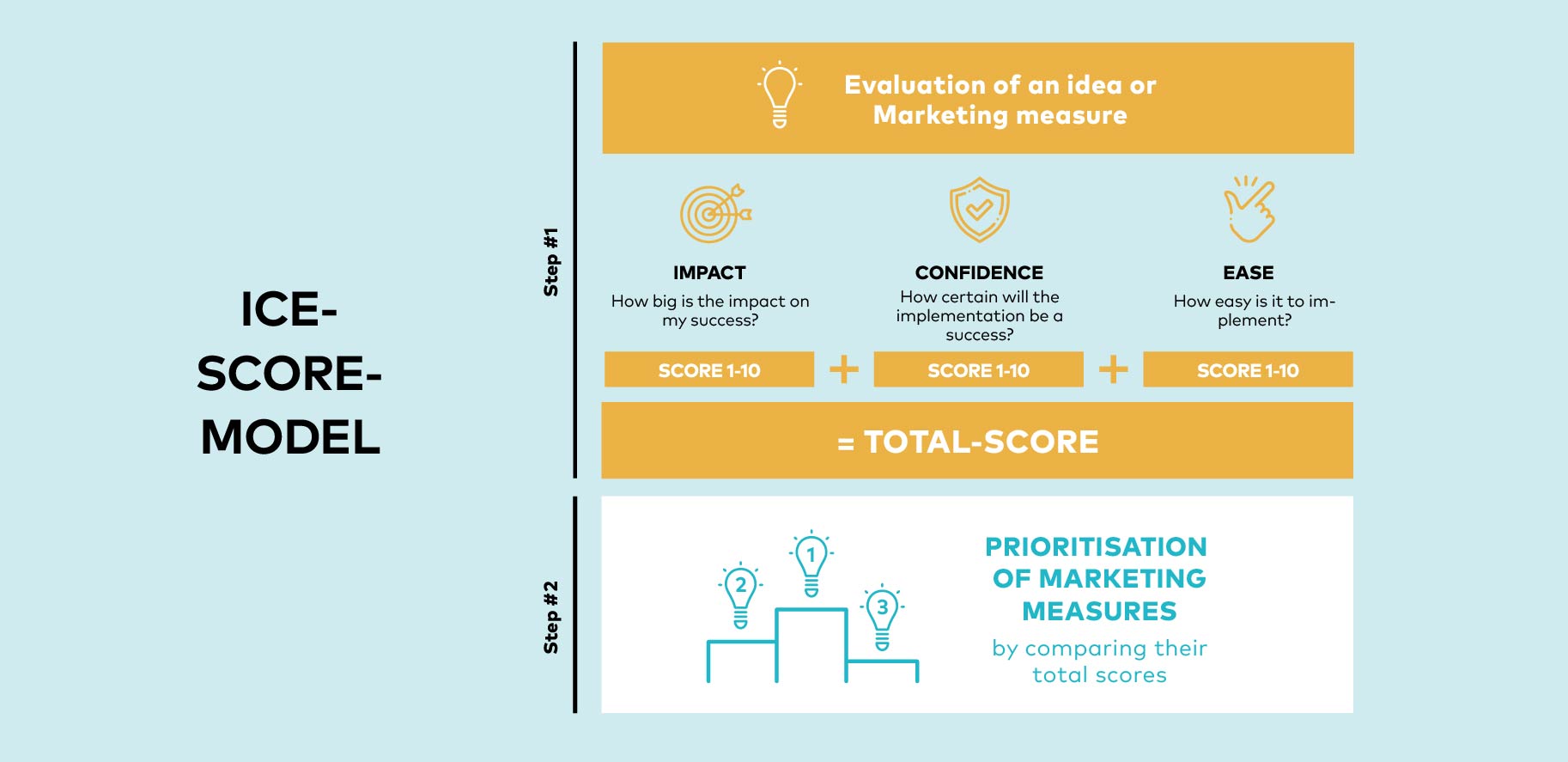
Scope of application of ICE scoring
Ideal for deciding what to do first if there are too many construction sites. It is suitable for all marketing decisions, from social media and email campaigns to SEO, and helps teams to tackle one thing at a time in a sensible order.
Pros:
-
Helps to prioritise and ensures quick decisions.
-
Helps you to concentrate on the essentials.
-
Makes it easier to use your resources and those of the team wisely.
Cons:
-
Sometimes gut feeling is also important, not just numbers.
-
Could overlook creative ideas that take longer to ignite.
Prompts to help you apply the method:
Be sure to add precise details of the individual marketing measures and ideas to the initial prompt suggestions below. The more precisely you describe what you intend to do in the prompt, the better the AI can help you. If you lack knowledge here, add the following note to the end of your prompt: First ask me a few questions to develop a prompt that promises maximum success.
Phase in the ICE-score model
Impact
Prompt
1. “What quantifiable improvements (e.g. traffic, conversion rate, sales) can we expect from this measure (please describe in detail!)?”
Explanation of why the prompt helps
This prompt helps to assess the potential impact of a measure on key performance indicators in order to understand its significance.
Prompt
2. “How does this measure contribute to achieving our long-term corporate goals (please specify!)?”
Explanation of why the prompt helps
This approach makes it possible to assess the strategic importance of a measure with regard to the company’s overarching objectives.
Confidence
Prompt
1. “What data, research findings or previous experience is our assessment of the probability of success of this measure based on?”
Explanation of why the prompt helps
This prompt calls for the use of empirical data in order to strengthen the certainty of the assessment of success.
Prompt
2. “On a scale of 1 to 10, how high do we estimate the probability that the expected impact will actually materialise?”
Explanation of why the prompt helps
A numerical evaluation promotes an objective assessment of confidence in the effectiveness of a measure.
Ease
Prompt
1. “What resources (time, budget, personnel) are required to implement this measure and how available are these resources at present?”
Erklärung, wieso der Prompt hilft
This prompt helps to assess the practical feasibility of a measure in the context of the available resources.
Prompt
2. “Are there any known challenges or obstacles to implementing this measure and how can we address them?”
Erklärung, wieso der Prompt hilft
Identifying and planning how to deal with potential challenges improves the realisability of the measure.
The RACE Strategy-Framework
Think of the RACE method as a four-round game that’s all about boosting your sales. Curious how it works? Well, here we go:
- First of all, it’s about getting there: This is where it all starts, because you determine what your specific marketing goal is. Do you want to retain customers, boost brand content or achieve reach? That’s exactly what you define here. Example: How cool would it be if everyone who searches for something related to your product area on Google comes across you? That’s your exemplary goal in this round. More Google visibility and more clicks on sales-relevant search queries!
- Act: You and your team now know what your goal is – very good! Now you need to think about what action you want users to take. Should they rate your brand, click on a banner ad, add something to their shopping basket? Maybe you can get them to click deep into your shop because you simply have irresistible content. How can you do that? Perhaps with a crisp design or stories that captivate? You think about that in this phase.
- Convert: Now it’s getting serious. People are interested, but how do you turn them into buyers? Perhaps with a limited-time offer or a discount for new customers? This is where clever tricks are needed to give people the final push. In the Convert phase, you put together ideas that turn prospects into enthusiastic customers.
- Binding: Strike: You’ve won a new customer! But now you have to keep at it. How do you ensure that they don’t just buy from you once, but become fans for life?
Scope of application of the RACE-framework
RACE is like a universal tool. Whether you are a small start-up or a large company, online or offline, you can always play this game to boost your sales.
Pros:
-
Clear overview: You always know which round you are currently playing in.
-
Flexible: You can adapt the rules of the game depending on what is best for your business.
-
Measurable: You can see exactly which moves are working and where you need to make improvements.
Cons:
-
Not always straightforward: sometimes people jump from one round to the next without following the rules.
-
A little tricky: it’s not always clear which tricks are the best in which round.
-
After the purchase is before the purchase: people often forget that the game goes on, even after someone has bought. Winning fans for life is also an important part of the game.
Prompts to help you apply the method:
Be sure to add precise details of the individual marketing measures and ideas to the prompt suggestions. The more precisely you describe what you intend to do in the prompt, the better the AI can help you. If you lack knowledge here, add the following note to the end of your prompt: First ask me a few questions to develop a prompt that promises maximum success.
Phase in the RACE framework
Reach
Prompt
1. “Which channels do our target customers use most frequently and how can we be present there to maximise our visibility?”
Explanation of why the prompt helps
This prompt helps to identify the most effective channels for the target group in order to increase reach and raise awareness of the brand.
Prompt
2. “How can we use SEO and content marketing to be at the top of relevant search queries?”
Explanation of why the prompt helps
This encourages companies to improve their online presence through targeted SEO measures, which increases their findability and visibility.
Act
Prompt
1. “What type of content (videos, blog posts, infographics) can best activate our target group and motivate them to take action?”
Explanation of why the prompt helps
The prompt aims to create engaging content that motivates the target group to interact and leads them deeper into the sales funnel.
Prompt
2. “How can we design a user-friendly landing page that encourages users to take the next step (e.g. registration, download)?”
Explanation of why the prompt helps
This helps to create a smooth user experience that leads to the desired action and increases the conversion rate.
Convert
Prompt
1. “What incentives (discounts, exclusive content, free samples) can we offer to turn prospects into buyers?”
Explanation of why the prompt helps
By offering clear incentives, prospective customers are motivated to complete the purchase, which increases the conversion rate.
Prompt
2. “How can we make the purchasing process as simple and transparent as possible to avoid abandoned purchases?”
Explanation of why the prompt helps
This encourages consideration to identify and remove potential barriers in the buying process, leading to more completed purchases.
Engage
Prompt
1. “How can we use personalised post-purchase communication to increase customer satisfaction and promote loyalty?”
Explanation of why the prompt helps
Personalised post-purchase communication strengthens customer loyalty and increases the likelihood of repeat purchases.
Prompt
2. “Which programmes or platforms can we use to create a community around our brand and retain customers in the long term?”
Explanation of why the prompt helps
This encourages people to think about ways of retaining customers in the long term through community building and engagement programmes.

The Flywheel-Framework: Focus on customer orientation
The Flywheel model is a customer-centric digital marketing strategy framework. The goal of all the features in the Flywheel model is to optimise the customer journey by removing ‘friction’ that slows down the buying process.
Think of the Flywheel model as a big wheel that takes your customers on a super journey without them getting “stuck” at any point. The whole model revolves around your customers having a smoothie-like experience with your brand, with no bumpy interruptions.
Here are the three phases of your customer journey in the Flywheel:
- Attract: Your goal is to make people curious. Show them what you have, be it through cool posts on social media or fancy adverts. You want them to think: “Hey, that looks interesting!
- Binding: Now that you’ve got their attention, it’s time to make friends. Let them know what you have to offer and show them that you’ve got what it takes. It’s about making them feel comfortable with you and thinking: “This is exactly what I need!”
- Inspire: Here’s your chance to turn them into real fans. Support them, make them feel special and make sure they think of you with a smile. If they’re happy, they’ll spread the word – and that’s how the wheel really gets rolling.
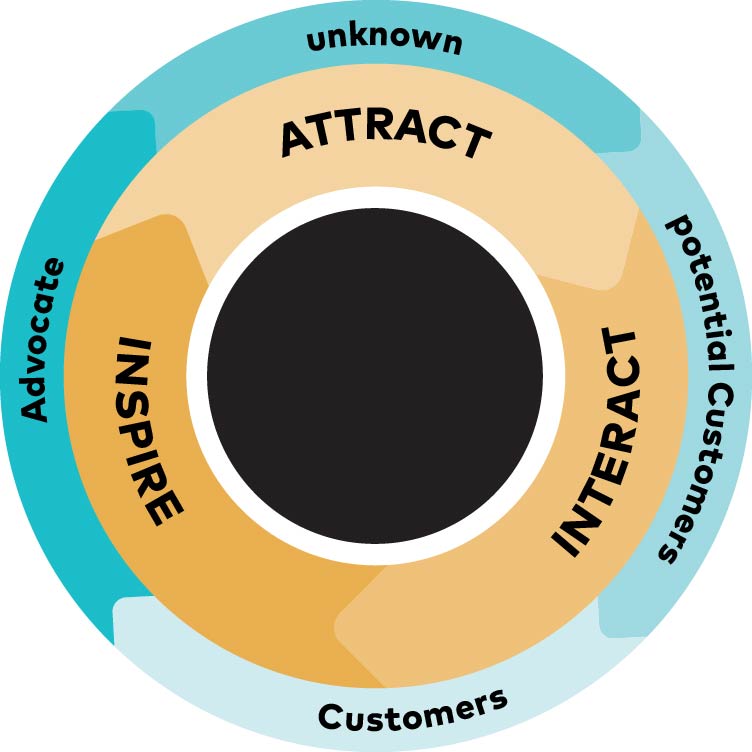
Area of application of the Flywheel-Model
Whether you run a start-up or an established company, online or offline, the Flywheel model always fits. It keeps your business running and your customers happy.
Pros:
-
Super customer-friendly: Your customers enjoy the journey from start to finish.
-
No stumbling blocks: You make it easy for your customers to buy from you and feel comfortable.
-
Word of mouth: Satisfied customers talk about you – the best marketing!
Cons:
-
Needs care: You have to keep the wheel turning so that it doesn’t get bogged down.
-
Not always easy: Sometimes it’s tricky to find out what really excites your customers.
-
Long-term investment: It may take a while before you see the fruits of your labour, but it’s worth it!
Prompts to help you apply the method:
Be sure to add precise details of the individual marketing measures and ideas to the prompt suggestions. The more precisely you describe what you intend to do in the prompt, the better the AI can help you. If you lack knowledge here, add the following note to the end of your prompt: First ask me a few questions to develop a prompt that promises maximum success.
Phase in the Flywheel – Modell
Attract
Prompt
1. “How can we arouse the interest of our target group through creative and unique content on social media or through targeted advertising campaigns?”
Explanation of why the prompt helps
This prompt helps to find innovative approaches to attract attention and arouse interest in the brand.
Prompt
2. “Which trends or needs of our target group can we address in order to position our offerings as solutions to their problems?”
Explanation of why the prompt helps
This encourages them to link the offers closely to the current needs and interests of the target group, which increases their appeal.
Binding
Prompt
1. “How can we build a relationship with our prospects through personalised communication and targeted engagement?”
Explanation of why the prompt helps
The prompt aims to promote personalised and relevant interactions that strengthen trust and loyalty to the brand.
Prompt
2. “How can we continuously provide value to our customers to convince them of the quality of our products or services?”
Explanation of why the prompt helps
This helps to develop strategies to constantly offer customers added value and encourage them in their decision-making.
Inspiring
Prompt
1. “What extraordinary experiences can we offer our customers to turn them into loyal fans and brand ambassadors?”
Explanation of why the prompt helps
Creating unique customer experiences increases customer satisfaction and promotes positive word of mouth.
Prompt
2. “How can we use feedback and customer opinions to improve our offerings and build a community around our brand?”
Explanation of why the prompt helps
This approach promotes the involvement of customers in the improvement process and strengthens the sense of belonging and loyalty to the brand.
SEE-THINK-DO-CARE Framework – developed with Google
The See-Think-Do-Care framework is a digital marketing strategy framework that divides the customer journey into three phases: See, Think and Do.
- The “See” phase is about attracting the attention of future customers. Where and how exactly does the customer find out about you and your offer for the first time?
- In the “Think” phase, the aim is to get prospective customers to think about making a purchase – so this is where things really get down to business. You ask yourself how you can turn your visitors’ curiosity into genuine interest.
- Finally, the “Do” phase aims to get customers to buy – the moment it all comes down to. Your visitors are ready to become your customers. It’s the icing on the cake of your efforts and shows that all the hard work is paying off.
- The care phase aims to look after the acquired customer in the best possible way. The customer should be satisfied with the purchase decision and continue to be delighted with suitable service offers after the purchase, thus becoming an advocate and fan of the brand!
By utilising the See-Think-Do-Care framework, you can not only increase the visibility and engagement of your brand, but also increase your sales. It is important to be aware of the challenges and continuously adapt the model to your specific needs and market conditions.
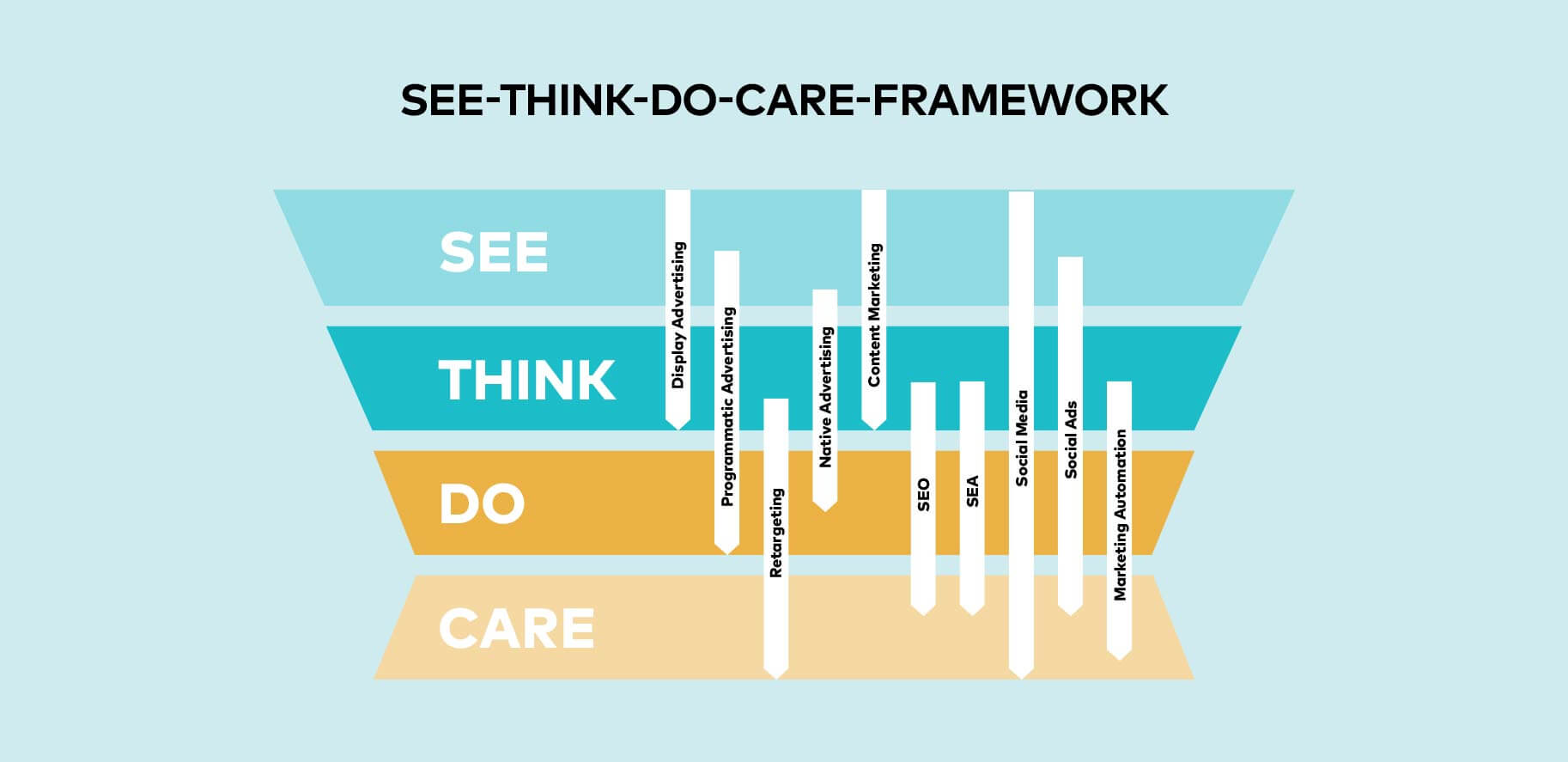
Areas of application of the See-Think-Do-Care-Framework
- Content-Marketing: Design content that is precisely tailored to the needs of your users in the various phases.
- Social Media Marketing: Use different strategies for the different phases to address your target group on platforms such as Instagram, Facebook or LinkedIn.
- E-Commerce: Optimise your online shop by improving the user experience from discovery to purchase.
- Customer loyalty: Develop strategies to retain existing customers and turn them into brand ambassadors.
Pros:
-
Targeted: The framework helps you to tailor your marketing strategies and campaigns precisely to the needs of your target group.
-
Structured: It provides a clear structure to understand and plan the customer journey.
-
Flexible: It can be applied to various marketing channels and instruments.
-
Measurable: You can check and adjust the success of your measures at every stage.
Cons:
-
Complexity: The model can be complex in practice, as users do not always go through the phases in a linear fashion.
-
Time required: It can take a lot of time and resources to develop and implement strategies for each phase.
-
Dynamic markets: Fast-moving market conditions can impair the effectiveness of the model if it is not regularly adjusted.
-
Data overload: Collecting and analysing data for each phase can be overwhelming and challenging.
By utilising the See-Think-Do-Care framework, you can not only increase the visibility and engagement of your brand, but also increase your sales. It is important to be aware of the challenges and continuously adapt the model to your specific needs and market conditions.
Prompts to help you apply the method:
Be sure to add precise details of the individual marketing measures and ideas to the prompt suggestions. The more precisely you describe what you intend to do in the prompt, the better the AI can help you. If you lack knowledge here, add the following note to the end of your prompt: First ask me a few questions to develop a prompt that promises maximum success.
Phase in the See-Think-Do-Care framework
See
Prompt
1. “How can we attract their attention through creative campaigns or content on the platforms where our target group hangs out?”
Explanation of why the prompt helps
This prompt helps to find innovative ways to reach the target group where they are already active and thus increase awareness of the brand.
Prompt
2. “What problems or needs of our target group can we address to create immediate relevance and interest?”
Explanation of why the prompt helps
This encourages the creation of content that directly addresses the needs and challenges of the target group in order to establish an immediate connection.
Think
Prompt
1. “What information or educational content can we provide to help potential customers in the consideration process?”
Explanation of why the prompt helps
The prompt aims to develop content that supports the target group in their decision-making process and converts interest into genuine purchase considerations.
Prompt
2. “How can we promote discussions or communities in which potential customers can share experiences and ask questions?”
Explanation of why the prompt helps
This promotes the development of a community and a dialog that helps interested parties to develop trust in the brand and engage more intensively with the purchase.
Do
Prompt
1. “What incentives or offers can we create to facilitate and accelerate the purchase decision?”
Explanation of why the prompt helps
By offering incentives or time-limited offers, potential customers are motivated to make the purchase, which increases conversions.
Prompt
2. “How can we make the purchasing process as simple and user-friendly as possible to minimize barriers?”
Explanation of why the prompt helps
This helps to optimize the buying process and remove potential obstacles, resulting in a higher conversion rate.
Care
Prompt
1. “How can we ensure ongoing communication and support after the purchase to maximize customer satisfaction?”
Explanation of why the prompt helps
Continuous support and communication after the purchase promote customer satisfaction and loyalty, which leads to loyal customers in the long term.
Prompt
2. “What additional values or services can we offer our customers to turn them into brand advocates?”
Explanation of why the prompt helps
This encourages them to offer added value beyond the purchase, which encourages customers to share positive experiences and actively support the brand.
The Pirate Metrics / AAARR model: from acquisition to customer retention
Pirate Metrics goes even further than the AIDA, Funnel or SEE-THINK-DO framework. It makes it easy for you to check the customer journey from the first encounter to the loyal fan – from the first hello to the happy regular customer who diligently recommends you to others. Dave McClure invented it so that start-ups can quickly see where things are still stuck. In five stages, it goes from lead acquisition to customer recommendation:
- the acquisition of a lead,
- the activation of the lead,
- the loyalty of the customer,
- the return you earn and
- the recommendation made by the customer
So first it’s about getting to know people – that’s where you check where and how people become aware of you. Then, when activating, you look at how you can turn interest into genuine enthusiasm. With retention, you keep your customers interested and see how often they come back. In the revenue part, you see whether the whole thing pays off. And the referral part is about whether your customers recommend you to others. Great for anyone who wants to understand their customers from A to Z!
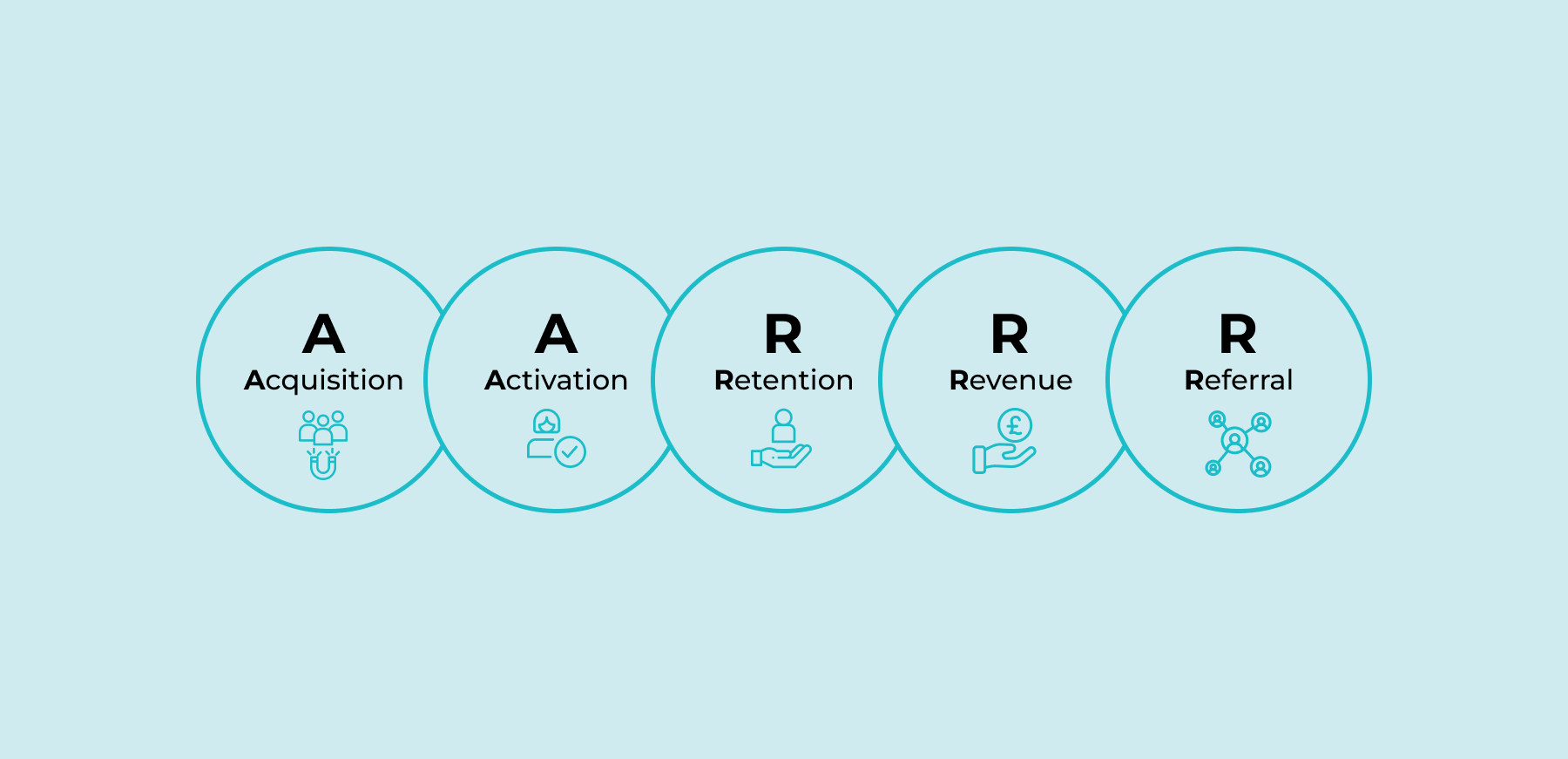
Areas of application of the Pirate Metrics model
- Perfect for start-ups and established companies
- Can be used everywhere, from online stores to service providers
Pros:
-
Gives a clear overview of the customer journey
-
Helps to optimize in a targeted manner and use resources correctly
Cons:
-
Can be a little complex at first
-
Requires continuous data analysis and adjustments
Prompts to help you apply the method:
Be sure to add precise details of the individual marketing measures and ideas to the prompt suggestions. The more precisely you describe what you intend to do in the prompt, the better the AI can help you. If you lack knowledge here, add the following note to the end of your prompt: First ask me a few questions to develop a prompt that promises maximum success.
The classic for the Internet – the funnel framework
Since the marketing funnel has already been explained so overused, we will refrain from extensive descriptions here – because the GROW experts always aim to provide you with a view beyond the horizon and surprise you – how about a non-binding conversation with Marcel – our GROW specialist, who can provide the right answers for almost every marketing, brand and e-commerce question?
So – test GROW and take the next step – contact us!


Curious about GROW's services?
Let’s chat about it over a cup of coffee!
Marcel Werner
Cross Solution & Sales Manager
